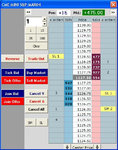Hi Paul,
Yes I agree with you, and t+s shows this as the mm is sitting there rock steady with large volume going off at his price, and if if there is no movement it can be concluded that as you say they are happy to pore stock/supply into the market which will give a resistance level on the chart.
I've seen this happen a few times in my short experience , so reading the situation at that moment/moments in time gives you the clues to wait for him to offload and look to see if the buying interest is still there and watch to see if the trades carry on, then move up as described earlier. If there is sentiment for a move up ,once past this resistance the dynamics change again.
Or as you say he can keep shovelling the stock into the market giving an oversupply of stock leading to a drop in demand and drop in price.
It is as you, Naz and Mr Charts have often said in the past, it isn't only at this moment in time that you get the story , it is the unfolding of the picture over time , be it 30 secs or 30 mins.
You mention the trades going off with green indications on the t+s are these the ones with the TRADE indicator alongside as opposed to the pacx,cinn,nasdaq incators. These appear when a move is about to happen up or down green or red. Do you have any other experiences or nuances you've picked up with these Paul?
Interesting topic.
Cheers
Triplepack

